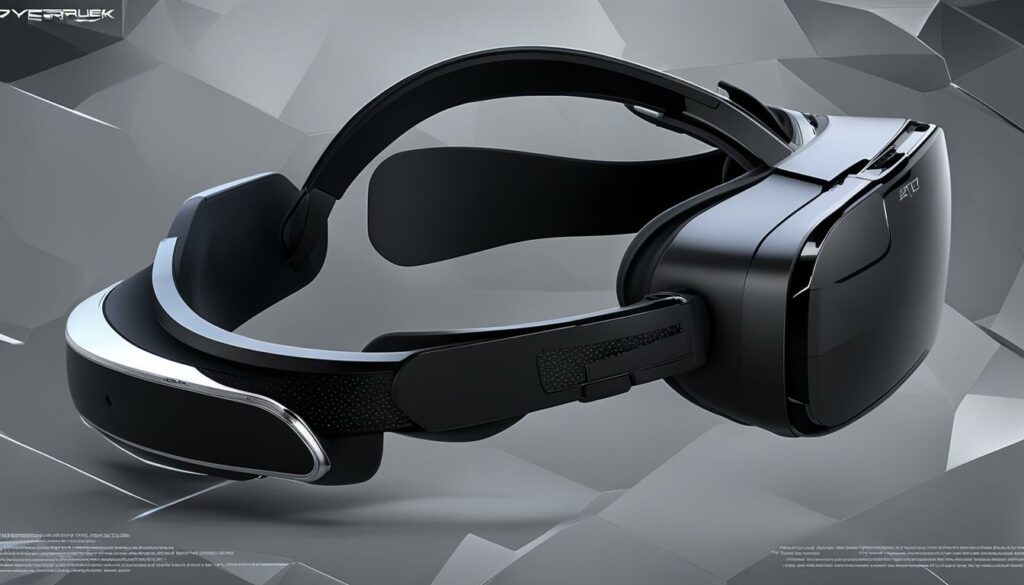Welcome to our comprehensive guide on hosting for augmented reality (AR) and virtual reality (VR) applications. As momentum continues to build for AR and VR in the enterprise, it’s important to understand the hosting solutions that power these immersive experiences. In this guide, we’ll delve into the world of AR and VR hosting, exploring its significance, benefits, and best practices.
AR and VR are transforming industries and revolutionizing the way we perceive and interact with digital content. From enhancing manufacturing processes to revolutionizing education and marketing, these technologies are opening up new possibilities.
Key Takeaways:
- AR and VR are rapidly gaining adoption in the enterprise.
- Hostin
What is Augmented and Virtual Reality?
Virtual reality (VR) and augmented reality (AR) are two groundbreaking technologies that have been rapidly advancing in recent years. Understanding the definitions and applications of these technologies is crucial in today’s digital landscape.
Virtual reality (VR) is an immersive technology that allows users to perceive and interact with a simulated environment. By using specialized hardware such as headsets, users are transported to a virtual world that feels remarkably realistic. VR can be used for various purposes, including gaming, training simulations, and even therapeutic applications.
Augmented reality (AR), on the other hand, enhances the real world by overlaying digital information onto a user’s field of view. Through the use of smartphones, tablets, smart glasses, or head-mounted displays, AR technology adds a layer of virtual content to the real world. This can range from displaying information about objects or locations to providing step-by-step instructions or interactive experiences.
Mixed reality is a subset of augmented reality that merges both the real and virtual worlds seamlessly. It allows users to interact with virtual objects as if they were part of the physical environment. Mixed reality brings a new level of immersion and interactivity, enabling innovative applications in fields like design, engineering, and entertainment.
Experience AR/VR through Hardware
To experience augmented and virtual reality, users rely on various hardware devices:
- Smartphones: With the help of dedicated apps, smartphones can be used as AR/VR devices, providing portable and accessible experiences.
- Tablets: Similar to smartphones, tablets offer a larger screen size and more immersive experience for AR/VR applications.
- Smart glasses: These specialized glasses, such as Microsoft HoloLens or Google Glass, overlay digital information directly in the user’s field of view.
- Head-mounted displays (HMDs): HMDs, like the Oculus Rift or HTC Vive, offer a fully immersive virtual reality experience by enclosing the user’s vision and providing a 360-degree view.
The Fusion of Reality and Technology
AR and VR technologies are at the forefront of innovation, revolutionizing numerous industries. From entertainment and gaming to healthcare and education, the applications are vast and diverse.
AR enhances your perception of reality, while VR transports you to a new world.
AR is often used to enhance the real world by providing additional information or visualizations. For example, AR can assist in architectural design by overlaying virtual models onto real spaces, allowing architects and clients to visualize concepts more effectively.
VR, on the other hand, offers a complete immersion into virtual environments, making it ideal for gaming, training simulations, and cinematic experiences. It provides users with a sense of presence in a digital world, enabling them to interact and explore like never before.
As technology advances, the lines between AR, VR, and mixed reality continue to blur. The combination of these technologies opens up even more possibilities for creative and practical applications.
Now that we have explored the definitions of augmented and virtual reality, let’s delve deeper into the specific applications of these technologies in the next section.
Enterprises are now exploring multiple applications of AR/VR
AR and VR technologies have expanded beyond gaming and entertainment, capturing the attention of enterprises across various industries. These immersive technologies offer innovative solutions that enhance operations, training, marketing, and customer experiences. Let’s explore some of the growing applications of AR/VR in the enterprise.
1. Guidance and Collaboration in Industries
In sectors like aerospace, manufacturing, and construction, AR/VR provides valuable guidance and collaboration tools. By overlaying digital information onto physical objects, workers can receive real-time instructions and visualize complex processes, reducing errors and improving efficiency. For example, engineers can leverage AR/VR to project 3D models for designing and assembling components in factories and warehouses.
2. Immersive Learning and Training in Healthcare and Education
In healthcare and education, AR/VR technologies offer immersive learning experiences that enhance training and education. Medical students can practice surgical procedures in virtual environments, allowing them to gain practical skills in a controlled setting. Similarly, students can explore historical sites or scientific phenomena through virtual field trips, making learning engaging and interactive.
3. Enhanced Consumer Experiences in Automotive and Retail
AR/VR has revolutionized the automotive and retail industries by creating immersive and interactive consumer experiences. In automotive showrooms, customers can use AR/VR to visualize and customize cars in 3D, helping them make informed purchase decisions and reducing the need for physical inventory. In retail, AR/VR technologies enable virtual try-on experiences, allowing customers to virtually try clothes, accessories, and even furniture before making a purchase.
4. Design and Analysis in Automotive and Banking
AR/VR has proven invaluable in design and analysis processes across various industries. In the automotive sector, engineers can use VR to simulate vehicle performance and conduct virtual tests before investing in physical prototypes. In the banking industry, AR/VR can provide clients with immersive financial visualization tools, simplifying complex data analysis and empowering them to make informed investment decisions.
These are just a few examples of how enterprises are leveraging AR/VR technologies to enhance various aspects of their operations. As the technology evolves and becomes more accessible, we can expect to see even more creative and impactful applications in the future.

The History of Virtual Reality (VR)
The history of virtual reality (VR) dates back to the 1930s when the first advancements in this technology were made. It all began with the development of flight simulators and stereoscopic viewers like the View-Master, which provided users with a simulated experience of flying and a 3D view of various environments.
In the 1960s and 1970s, inventors began experimenting with VR headsets, paving the way for immersive experiences. It was during this time that the term “virtual reality” was coined, and the concept started gaining traction.
However, it was in 1987 that virtual reality truly started to take shape with the founding of the company VPL Research by Jaron Lanier. Lanier and his team developed VR headsets and gloves, allowing users to interact with the virtual world in more intuitive ways.
From the 1990s onwards, VR gained popularity and saw rapid advancements, with companies like Facebook, Google, Samsung, and Microsoft investing heavily in VR technology. These developments led to the creation of high-quality VR devices that are now accessible to consumers and businesses alike.
Today, virtual reality is used in various fields, including gaming, entertainment, education, medicine, and more. It continues to evolve and innovate, pushing the boundaries of what is possible in terms of immersion and user experience.
| Decade | Key Virtual Reality Inventions |
|---|---|
| 1930s | Development of flight simulators Introduction of stereoscopic viewers like the View-Master |
| 1960s-1970s | Invention of VR headsets |
| 1987 | Coined the term “virtual reality” Development of VR headsets and gloves |
| 1990s-Present | Rapid advancements in VR technology Investments by major companies like Facebook, Google, Samsung, and Microsoft |
The history of virtual reality is a testament to our fascination with creating immersive experiences. From its humble beginnings to the cutting-edge technology of today, VR has come a long way, and its journey is far from over.

The Evolution of VR Devices
The development of virtual reality has led to the creation of various innovative devices that enhance the VR experience. Here are some notable VR devices that have contributed to the evolution of this technology:
- Oculus Rift: Developed by Oculus VR, a subsidiary of Facebook, the Oculus Rift is one of the most popular VR headsets available. It offers high-resolution displays and precise motion tracking, providing users with an immersive and realistic VR experience.
- HTC Vive: Created in collaboration with Valve, the HTC Vive offers room-scale tracking, allowing users to freely move around in a virtual environment. Its controllers provide realistic haptic feedback, further enhancing the sense of presence.
- PlayStation VR: Designed for use with the PlayStation 4 gaming console, the PlayStation VR brings VR gaming to a wider audience. With its affordable price and compatibility with the PlayStation ecosystem, it has made VR more accessible to console gamers.
- Google Cardboard: As a budget-friendly VR option, Google Cardboard uses a smartphone as the display and provides a simple, yet enjoyable, VR experience. It has paved the way for other mobile VR platforms and applications.
These devices, along with many others, have revolutionized the way we interact with and experience virtual reality. As technology continues to advance, we can expect even more exciting developments in the realm of virtual reality.
Augmented Reality (AR) vs. Virtual Reality (VR)
When it comes to immersive experiences, Augmented Reality (AR) and Virtual Reality (VR) are two technologies that have taken the world by storm. Both AR and VR offer unique ways to engage with digital content, but they do so in different ways.
In AR, digital content is overlaid onto the real world, creating an enhanced version of reality. Through the use of devices like smartphones and smart glasses, users can experience AR by seeing virtual objects or information in their real environment. AR is less immersive than VR as it focuses on enhancing the real world rather than creating an entirely new one.
On the other hand, VR completely transports users to a different world. By using headsets or other devices, VR allows users to fully immerse themselves in a digital environment that feels real and lifelike. Whether it’s exploring a virtual game world or taking a virtual tour of a faraway place, VR provides a truly immersive experience that can transport users to new realities.
“AR enhances the real world, while VR creates a new one.”
Let’s delve deeper into the differences between AR and VR:
AR:
- Enhances the real world with digital content
- Offers an overlay of information onto the user’s real environment
- Can be experienced through devices like smartphones and smart glasses
VR:
- Creates a completely new digital environment
- Immerses users in a virtual world, making them feel like they are somewhere else
- Requires the use of headsets or other VR devices
Both AR and VR have their own unique applications and advantages. AR is well-suited for industries like retail, where it can enhance the shopping experience by overlaying product information or virtual try-ons. VR, on the other hand, is widely used in gaming, entertainment, and even healthcare for simulations and therapeutic experiences.
| AR | VR |
|---|---|
| Enhances the real world | Creates a new world |
| Less immersive | Fully immersive |
| Overlay of digital content | Complete virtual environment |
| Experienced through smartphones and smart glasses | Requires headsets or VR devices |
Whether it’s AR or VR, both technologies offer exciting opportunities for various industries and provide users with immersive experiences like never before. The choice between AR and VR ultimately depends on the specific needs and goals of the application or experience.
Virtual Reality Applications and Examples
Virtual reality (VR) technology has revolutionized various industries, offering immersive experiences and endless possibilities. Let’s explore some key applications of virtual reality in education, medicine, and other sectors.
Virtual Reality in Education
Virtual reality has transformed education, bringing subjects to life and enhancing learning experiences. Students can step into historical events, explore distant locations, and visualize complex scientific concepts. VR is used in classrooms to:
- Facilitate immersive virtual field trips
- Simulate hands-on laboratory experiments
- Enhance language learning through virtual conversations
- Provide training for technical skills in a safe environment
Through these applications, virtual reality is revolutionizing the way students learn and interact with educational content.
Virtual Reality in Medicine
In the field of medicine, virtual reality has proven to be a valuable tool for both patient care and medical training. VR applications are utilized to:
- Reduce pain and anxiety during medical procedures
- Help patients overcome phobias and manage chronic conditions
- Support rehabilitation and physical therapy
- Enhance surgical planning and visualization
- Provide realistic simulations for medical training
From reducing patient discomfort to empowering medical professionals, virtual reality is making a significant impact in the healthcare industry.
Virtual Reality in Other Industries
Aside from education and medicine, virtual reality is also making its mark in various sectors:
- Marketing: VR is being used to create immersive brand experiences and interactive product demonstrations.
- Entertainment: VR gaming, virtual theme parks, and immersive cinematic experiences are gaining popularity.
- Architecture and Design: Virtual reality enables architects and designers to visualize spaces, improve design communication, and showcase projects to clients.
These are just a few examples highlighting the versatility and widespread adoption of virtual reality across industries.

| Industry | Application of Virtual Reality |
|---|---|
| Education | Enhanced learning experiences through virtual field trips and simulations |
| Medicine | Pain management, medical training, surgical planning |
| Marketing | Creating immersive brand experiences and interactive product demonstrations |
| Entertainment | VR gaming, virtual theme parks, cinematic experiences |
| Architecture and Design | Visualization of spaces, improved design communication |
Conclusion
Hosting providers are essential for the successful operation and optimal performance of AR/VR applications. As the adoption of AR/VR technology continues to surge, the need for reliable and scalable hosting solutions becomes increasingly crucial. AR/VR hosting offers numerous benefits that contribute to improved user experiences, enhanced collaboration and training capabilities, and exciting new opportunities for businesses in various industries.
When it comes to AR/VR applications, seamless performance is vital. Hosting providers ensure that the infrastructure is in place to handle the demanding requirements of these immersive technologies. By leveraging powerful servers, robust networks, and comprehensive technical support, hosting for AR/VR can deliver the necessary speed, reliability, and uptime to ensure a smooth user experience.
Furthermore, AR/VR hosting enables enhanced collaboration and training capabilities. With the ability to host and share AR/VR content on a centralized platform, businesses can foster remote collaboration, allowing team members to work together on projects regardless of their physical location. Additionally, AR/VR training can be conducted virtually, offering employees a lifelike learning experience that is both engaging and efficient.
The future of AR/VR is promising, with the technology expected to revolutionize numerous industries. Hosting providers that specialize in AR/VR can support this transformation by offering tailored hosting solutions that are designed to meet the specific needs of AR/VR applications. As the demand for AR/VR continues to grow in fields such as healthcare, manufacturing, marketing, and education, businesses will rely on hosting services that can accommodate the increased data storage, bandwidth, and processing power required to drive these immersive experiences forward.
FAQ
Q: What is hosting for augmented reality?
A: Hosting for augmented reality refers to the infrastructure and services necessary to ensure the smooth operation and performance of AR applications. Hosting providers offer reliable and scalable solutions to support the storage, processing, and delivery of AR content to end-users.
Q: What is hosting for virtual reality?
A: Hosting for virtual reality involves the infrastructure and services required to enable the seamless functioning and performance of VR applications. Hosting providers offer reliable and scalable solutions to handle the storage, processing, and distribution of VR content to users.
Q: How can hosting benefit augmented and virtual reality applications?
A: Hosting for AR/VR applications offers several benefits, including improved user experiences, enhanced collaboration and training capabilities, and new opportunities for businesses across various industries. Reliable and scalable hosting solutions ensure that AR/VR applications run smoothly and efficiently.
Q: What are augmented reality and virtual reality?
A: Augmented reality (AR) overlays digital content onto the real world, enhancing the user’s perception of reality. Virtual reality (VR) creates a completely new digital environment, immersing the user in a simulated reality. Mixed reality is a subset of AR that combines elements of both the real and virtual worlds.
Q: What are some applications of AR/VR in enterprise?
A: Enterprises are exploring various applications of AR/VR, including guidance and collaboration in industries like aerospace and manufacturing, immersive learning and training in healthcare and education, enhanced consumer experiences in sectors like automotive and retail, and design and analysis in industries such as automotive and banking.
Q: What is the history of virtual reality?
A: Virtual reality has a rich history dating back to the 1930s, with the development of flight simulators and stereoscopic viewers like the View-Master. VR headsets were invented in the 1960s and 1970s, and the term “virtual reality” was coined in 1987. The 1990s saw the rise in popularity of VR, and advancements in the 21st century have led to the development of VR devices by companies like Facebook, Google, Samsung, and Microsoft.
Q: What is the difference between augmented reality and virtual reality?
A: Augmented reality (AR) overlays digital content onto the real world, enhancing the user’s perception of reality. Virtual reality (VR) creates a completely new digital experience that transports the user to a different world. AR is less immersive and focuses on enhancing the real world, while VR is fully immersive and provides a simulated reality.
Q: What are some examples of virtual reality applications?
A: Virtual reality has a wide range of applications, including education, where VR is used for training and learning purposes. In medicine, VR is used to help patients cope with treatments and for training purposes. Other industries like marketing, entertainment, and architecture are also utilizing VR technology for various purposes.
Q: What does the future hold for hosting for AR/VR?
A: As the adoption of AR/VR technology continues to grow, the need for reliable and scalable hosting solutions will become even more important. Hosting providers will play a crucial role in ensuring the seamless operation and performance of AR/VR applications, enabling businesses to embrace the full potential of these technologies.












